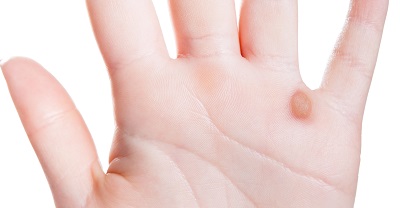
Warts are common growths caused by the Human papilloma virus. This virus is on growths and many surfaces we are in contact with. Frequent touching or picking may cause them to spread. It is best to avoid direct contact with warts on other people. Warts may develop on any part of the body but are most commonly seen on the hands, feet and genital area. There are different types of treatment for warts from the least aggressive to surgery. Even with the most aggressive treatment, warts can reoccur because a wart is a virus and our own body needs to recognize the virus to eradicate it. Depending on the type of wart and location we will work to find the best treatments to clear the warts.
Facts about Warts
There are an estimated three million (3,000,000) new cases of warts a year in the United States. Warts are very common, with most people being infected at some point in time. The estimated current rate of common warts among the general population is 1–13%. They are more common among young people.
Warts are typically small, rough, and hard growths that are similar in color to the rest of the skin. They typically do not result in symptoms except when on the bottom of the feet where they may be painful. While they usually occur on the hands and feet they can also affect other locations. One or many warts may appear. They are not cancerous.
Warts are caused by infection with a type of Human Papillomavirus (HPV). Factors that increase the risk include use of public showers, Eczema, and a compromised immune system. The virus is believed to enter the body through skin that has been damaged slightly. A number of types exist including: common warts, plantar warts, filiform warts, and genital warts.
Without treatment, most types of warts resolve in months to years spontaneously. Most are painless, but larger ones on the sole of the foot can be painful.
Risk Factors
Warts (Verruca Vulgaris) are caused by a contagious virus. Therefore, contact with an infected area of an infected person is not recommended. And, this type of contact should be avoided. Public areas that results in skin on skin contact such as toilets, public showers, locker room floors, door handles, gym equipment, and wrestling mats should be disinfected prior to touching. Avoid direct contact with potential infectious sources, for example, when opening restroom doors or accessing faucets with a paper towels use a paper towel. Use provided disinfectant wipes at gyms before and after use of a piece of equipment. Wear foot coverings when using public showers.
Presentation of Warts
Common Wart (Verruca Vulgaris): A raised wart with roughened surface, most common on hands, but can grow anywhere on the body.
Flat Wart (Verruca Plana): A small, smooth flattened wart, flesh-coloured, which can occur in large numbers; most common on the face, neck, hands, wrists and knees.
Filiform or Digitate Wart, a thread- or finger-like wart: Most common on the face, especially near the eyelids and lips.
Mosaic Wart: A group of tightly clustered plantar-type warts, commonly on the hands or soles of the fee.
Periungual Wart: A cauliflower-like cluster of warts that occurs around the nails.
Plantar wart (verruca, Verruca plantaris): A hard sometimes painful lump, often with multiple black specks in the center; usually only found on pressure points on the soles of the feet.
Treatment of Warts
Over the Counter (OTC) Medications
Salicylic Acid: Applications of salicylic acid gel or impregnated bandages are available over the counter.
Dimethyl and Ether: Available to use without prescription to freeze the warts.
Prescription Medications
- Imiquimod Cream (Aldara, Zyclara)
- Dinitrochlorobenzene (DNCB) Applied directly to the wart.Diclofenac gel
Procedural Methods
Freezing (Cryotherapy): Warts can be removed by freezing them with liquid nitrogen. Your doctor applies the substance to the affected skin, which causes blistering or peeling. As your skin heals, the lesions slough off, allowing new skin to appear. Cryotherapy is the most common treatment. It takes only a few minutes and can be done in your doctor’s office. Side effects may include blisters, scarring, skin texture changes, infection and darkening of the skin at the site of treatment.
Scraping (Curettage): In this procedure, your surgeon uses a device called a curette to scrape off damaged cells. Scraping may be followed by electro-surgery, in which the doctor uses a pencil-shaped instrument to cut and destroy the affected tissue with an electric current. This procedure requires a local anesthetic. Side effects may include infection, scarring and changes in skin coloration at the site of treatment.
Cantharidin: Causes dermal blistering. It is used either by itself or compounded with podophyllin.
Intralesional Therapy: Bleomycin or 5-Fluorouracil may be injected in the actual wart.
Immune Therapy: Usually an option for multiple or numerous warts for which cryotherapy, cantharidin, or curettage is not advised. Candidal Antigen is injected into a single wart, usually the largest. This may trigger an immune reaction that causes consumes all warts.
Laser Treatment: Pulse dye laser or Carbon Dioxide (CO2) laser. Pulse dye lasers (wavelength 582 nm) work by selective absorption by blood cells (specifically hemoglobin). CO2 lasers work by selective absorption by water molecules. Pulse dye lasers are less destructive and more likely to heal without scarring. CO2 laser works by vaporizing and destroying tissue and skin.
Photodynamic Therapy: Application of Aminolevulinic Acid to the treatment area and then activating with a light source.
Infrared Coagulator: An intense source of infrared light in a small beam like a laser
Occlusion Therapy: Duct -tape or other occlusive dressing.

